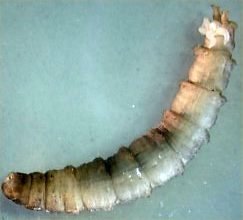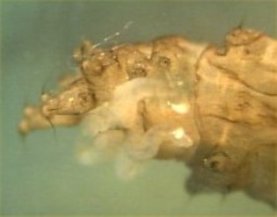Reproduction/Life History
Adult Tipula submaculata lay slender eggs in a moist
environment normally near open water. Generally in the spring,
the eggs hatch into a larval form. The larvae a of
Tipula are
generally known as a ‘leatherjackets’ because of their tough
outer layer (O’Toole 2002). Some species are known pests of
grasses, rangelands, rice fields, and golf courses. After a
larval stage, Tipula submaculata grow into the adult flying
stage which lasts anywhere from 10 to 15 days. The main goal
of the adult stage is mating and laying eggs
(Red Planet Inc.
2012).

Life Cycle
Crane Fly Larvae
Tipula Submaculata and the marsh crane fly are very comparable, sharing
the same Genus Tipula. The close relationship of the
two species allows for a comparison of lifestyle and
reproductive behaviors. The marsh crane fly completes one life
generation per year. Adults are found abundantly in late August
and early September. The eggs that are laid by the females are
black and shiny. Each female will lay their eggs on the soil
surface and can lay up to 280 eggs. The eggs will hatch 11-15
days from when they are laid. Larvae remain in the soil during
fall and winter. They then grow rapidly in spring and reach
their full length, about 40mm, by May. The larvae will then enter
the pupa stage in July.
Pupae will then remain underground for
2 weeks as they head for the surface. The adult then emerges
from the pupal case after sunset and immediately mates. The males
live for about 7 days while the females live 4 to 5 days
(Arthur and Garrison 2004).

Crane Fly larva terminal segment
To Return Home
Continue to Interactions